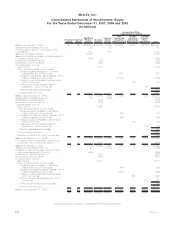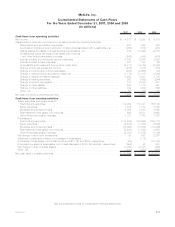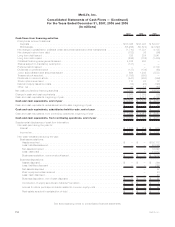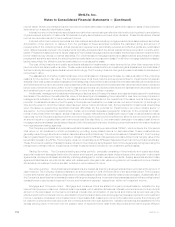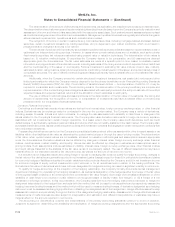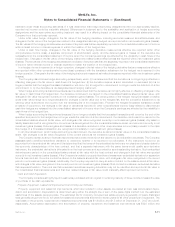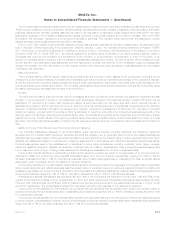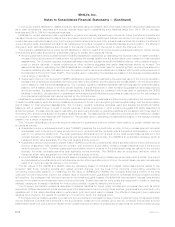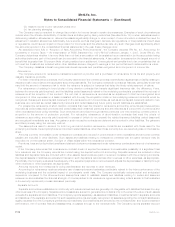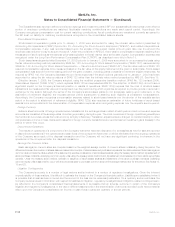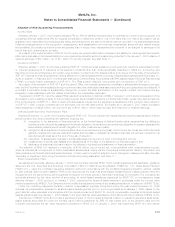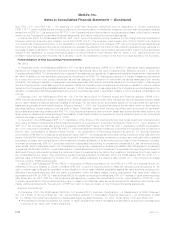MetLife 2007 Annual Report Download - page 108
Download and view the complete annual report
Please find page 108 of the 2007 MetLife annual report below. You can navigate through the pages in the report by either clicking on the pages listed below, or by using the keyword search tool below to find specific information within the annual report.$721 million at December 31, 2007 and 2006, respectively. Related depreciation and amortization expense was $136 million, $129 million
and $117 million for the years ended December 31, 2007, 2006 and 2005, respectively.
Computer software, which is included in other assets, is stated at cost, less accumulated amortization. Purchased software costs, as
well as certain internal and external costs incurred to develop internal-use computer software during the application development stage,
are capitalized. Such costs are amortized generally over a four-year period using the straight-line method. The cost basis of computer
software was $1.4 billion and $1.2 billion at December 31, 2007 and 2006, respectively. Accumulated amortization of capitalized software
was $876 million and $752 million at December 31, 2007 and 2006, respectively. Related amortization expense was $126 million,
$112 million and $111 million for the years ended December 31, 2007, 2006 and 2005, respectively.
Deferred Policy Acquisition Costs and Value of Business Acquired
The Company incurs significant costs in connection with acquiring new and renewal insurance business. Costs that vary with and relate
to the production of new business are deferred as DAC. Such costs consist principally of commissions and agency and policy issue
expenses. VOBA is an intangible asset that reflects the estimated fair value of in-force contracts in a life insurance company acquisition and
represents the portion of the purchase price that is allocated to the value of the right to receive future cash flows from the business in-force
at the acquisition date. VOBA is based on actuarially determined projections, by each block of business, of future policy and contract
charges, premiums, mortality and morbidity, separate account performance, surrenders, operating expenses, investment returns and other
factors. Actual experience on the purchased business may vary from these projections. The recovery of DAC and VOBA is dependent upon
the future profitability of the related business. DAC and VOBA are aggregated in the financial statements for reporting purposes.
DAC for property and casualty insurance contracts, which is primarily composed of commissions and certain underwriting expenses, is
amortized on a pro rata basis over the applicable contract term or reinsurance treaty.
DAC and VOBA on life insurance or investment-type contracts are amortized in proportion to gross premiums, gross margins or gross
profits, depending on the type of contract as described below.
The Company amortizes DAC and VOBA related to non-participating and non-dividend-paying traditional contracts (term insurance,
non-participating whole life insurance, non-medical health insurance, and traditional group life insurance) over the entire premium paying
period in proportion to the present value of actual historic and expected future gross premiums. The present value of expected premiums is
based upon the premium requirement of each policy and assumptions for mortality, morbidity, persistency, and investment returns at policy
issuance, or policy acquisition, as it relates to VOBA, that include provisions for adverse deviation and are consistent with the assumptions
used to calculate future policyholder benefit liabilities. These assumptions are not revised after policy issuance or acquisition unless the
DAC or VOBA balance is deemed to be unrecoverable from future expected profits. Absent a premium deficiency, variability in amortization
after policy issuance or acquisition is caused only by variability in premium volumes.
The Company amortizes DAC and VOBA related to participating, dividend-paying traditional contracts over the estimated lives of the
contracts in proportion to actual and expected future gross margins. The amortization includes interest based on rates in effect at inception
or acquisition of the contracts. The future gross margins are dependent principally on investment returns, policyholder dividend scales,
mortality, persistency, expenses to administer the business, creditworthiness of reinsurance counterparties, and certain economic
variables, such as inflation. For participating contracts (dividend paying traditional contracts within the closed block) future gross margins
are also dependent upon changes in the policyholder dividend obligation. Of these factors, the Company anticipates that investment
returns, expenses, persistency, and other factor changes and policyholder dividend scales are reasonably likely to impact significantly the
rate of DAC and VOBA amortization. Each reporting period, the Company updates the estimated gross margins with the actual gross
margins for that period. When the actual gross margins change from previously estimated gross margins, the cumulative DAC and VOBA
amortization is re-estimated and adjusted by a cumulative charge or credit to current operations. When actual gross margins exceed those
previously estimated, the DAC and VOBA amortization will increase, resulting in a current period charge to earnings. The opposite result
occurs when the actual gross margins are below the previously estimated gross margins. Each reporting period, the Company also
updates the actual amount of business in-force, which impacts expected future gross margins.
The Company amortizes DAC and VOBA related to fixed and variable universal life contracts and fixed and variable deferred annuity
contracts over the estimated lives of the contracts in proportion to actual and expected future gross profits. The amortization includes
interest based on rates in effect at inception or acquisition of the contracts. The amount of future gross profits is dependent principally
upon returns in excess of the amounts credited to policyholders, mortality, persistency, interest crediting rates, expenses to administer the
business, creditworthiness of reinsurance counterparties, the effect of any hedges used, and certain economic variables, such as inflation.
Of these factors, the Company anticipates that investment returns, expenses, and persistency are reasonably likely to impact significantly
the rate of DAC and VOBA amortization. Each reporting period, the Company updates the estimated gross profits with the actual gross
profits for that period. When the actual gross profits change from previously estimated gross profits, the cumulative DAC and VOBA
amortization is re-estimated and adjusted by a cumulative charge or credit to current operations. When actual gross profits exceed those
previously estimated, the DAC and VOBA amortization will increase, resulting in a current period charge to earnings. The opposite result
occurs when the actual gross profits are below the previously estimated gross profits. Each reporting period, the Company also updates
the actual amount of business remaining in-force, which impacts expected future gross profits.
Separate account rates of return on variable universal life contracts and variable deferred annuity contracts affect in-force account
balances on such contracts each reporting period. Returns that are higher than the Company’s long-term expectation produce higher
account balances, which increases the Company’s future fee expectations and decreases future benefit payment expectations on
minimum death benefit guarantees, resulting in higher expected future gross profits. The opposite result occurs when returns are lower
than the Company’s long-term expectation. The Company’s practice to determine the impact of gross profits resulting from returns on
separate accounts assumes that long-term appreciation in equity markets is not changed by short-term market fluctuations, but is only
changed when sustained interim deviations are expected. The Company monitors these changes and only changes the assumption when
its long-term expectation changes.
F-12 MetLife, Inc.
MetLife, Inc.
Notes to Consolidated Financial Statements — (Continued)




